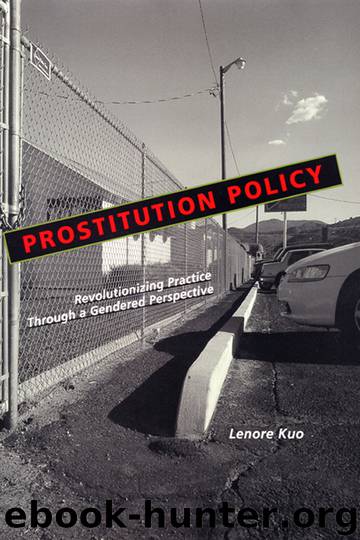Prostitution Policy by Kuo Lenore; & Lenore Kuo

Author:Kuo, Lenore; & Lenore Kuo
Language: eng
Format: epub
Publisher: New York University Press
Published: 2002-12-08T16:00:00+00:00
6
The “Ideal” Character of Heterosex/Intercourse and Prostitution
Ideal Heterosex/Intercourse
Much of the stigma that attaches to objects and activities in a culture reflect that culture’s social construction of power. This is critical to understanding a feminist reconstruction of heterosexual activity. What, from a feminist perspective, would an ideal of heterosexuality and heterosexual activity be? What would heterosexuality and heterosexual activity look like in a nonsexist world? My first instinct is to say that I haven’t a clue. Heterosexual activity and its representations are so deeply shaped and limited by patriarchy that it is impossible for me, as an individual whose views are inextricably constructed by my cultural context, to envision what nonsexist heterosexuality would look like in any detail. But I can, in fact, envision such an ideal in a decidedly broad outline, particularly in terms of those qualities that currently construct heterosexual acts but would surely be absent or altered in a nonpatriarchal context.
During my 1993 discussion of his recently completed report on trafficking between Belgium and the Netherlands, the Dutch criminologist Cyrille Fijnaut said with great certainty, “You’ll never normalize prostitution.” Given what I knew of Fijnaut’s work, as well as my knowledge of the Dutch government position which he has influenced, this comment surprised me. I thought about it for some time and finally came to believe that Fijnaut was partially correct. We will never normalize prostitution unless we normalize sex and sexual activity. And we will never normalize sex and sexual activity unless we normalize women. Unless women are normalized, gender and sexual identities will remain a source of oppression. In a nonsexist world, sexuality, genitalia, and sexual acts would be normalized. Any act that does not cause harm to another would be viewed as not just acceptable but unworthy of any special notice. Although I am unable to agree that sexuality and reproduction are the source of women’s oppression (as many radical feminists traditionally have contended), I am certain that sexuality and reproduction constitute one of the most important sources and focuses of women’s oppression. From heterosexism to rape, from the madonna/whore dichotomy to the cultural rejection of “illegitimate” children, women have been made to pay for our sexuality and reproductive functions by the cultural valuation of these as sacred or profane. Because sexual acts and reproduction are currently bifurcated into either stigmatized or mystified behavior, they are made abnormal, morally value-tiered and definers of moral character. This abnormalization is central to the subordination of women.
A social stigma emerges in response to some feature(s) in the nature of certain objects or behaviors that are seen as problematic in the context of specific cultures. Sometimes those features are relevant to the welfare of the culture, sometimes not. I firmly believe that part of the stigma that attaches to acts of sexuality is related to the historical biological consequences that may follow from various sexual activities. Because heterosexual intercourse can, intrinsically, be the source of spreading diseases or of unplanned and unwanted pregnancies, it is not surprising that many cultures have stigmatized it and other sexual behavior that may encourage intercourse.
Download
This site does not store any files on its server. We only index and link to content provided by other sites. Please contact the content providers to delete copyright contents if any and email us, we'll remove relevant links or contents immediately.
| Anthropology | Archaeology |
| Philosophy | Politics & Government |
| Social Sciences | Sociology |
| Women's Studies |
The Secret History by Donna Tartt(18225)
The Social Justice Warrior Handbook by Lisa De Pasquale(11963)
Thirteen Reasons Why by Jay Asher(8472)
This Is How You Lose Her by Junot Diaz(6463)
Weapons of Math Destruction by Cathy O'Neil(5854)
Zero to One by Peter Thiel(5507)
Beartown by Fredrik Backman(5372)
The Myth of the Strong Leader by Archie Brown(5249)
The Fire Next Time by James Baldwin(5033)
How Democracies Die by Steven Levitsky & Daniel Ziblatt(4971)
Promise Me, Dad by Joe Biden(4916)
Stone's Rules by Roger Stone(4874)
100 Deadly Skills by Clint Emerson(4700)
A Higher Loyalty: Truth, Lies, and Leadership by James Comey(4566)
Rise and Kill First by Ronen Bergman(4554)
Secrecy World by Jake Bernstein(4406)
The David Icke Guide to the Global Conspiracy (and how to end it) by David Icke(4396)
The Farm by Tom Rob Smith(4332)
The Doomsday Machine by Daniel Ellsberg(4253)
